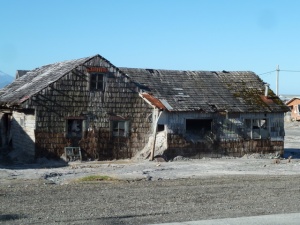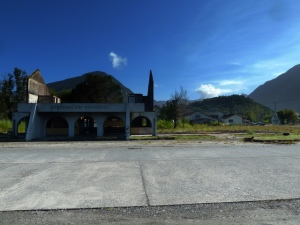We were in Junin de los Andes, Argentina, which bills itself as the fly fishing capital of the province, the first time we heard of ash from some Chilean volcano. I, Henrik, had hired a guide for a day – a beautiful day – of fly fishing, and my guide, Nicolas, mentioned that the river we were going to fish had not been affected by the ash.
Trying to not sound like too much of an uninformed tourist, I said: “So, what rivers were affected the most?” Nicolas said that the closer we got to Bariloche, south of Junin de los Andes, the worse it would get, and that Villa Angostura in particular had been hit hard. The fishing was great and I didn’t think too much more about the ash that day.
Two days later, Karen and I headed to Villa Traful, a very small town located on the gorgeous Lago Traful. The closer we got to Villa Traful, the more we started noticing what we now knew to be volcanic ash. Driving down the road, we saw a few inches of ash alongside the road, and we were pulling up a huge and lengthy dust cloud behind the Casa.
In Villa Traful itself, we spoke with the owner of the campground we stayed at; he mentioned that the campground had been covered by 4” (four inches!) of ash after the eruption of the Puyehue volcano, and that his business was down 80% for the summer. Although they had done a great deal of work cleaning up the campground, everything was dusty, and the slightest amount of wind would pull up a new dust cloud.
We were starting to understand that the Puyehue eruption had been a major one.
After Villa Traful, we went to Bariloche, and from Bariloche, we crossed into Chile via Villa Angostura, and ultimately via the Puyehue National Park. Ash was piled like snow along the road on the Argentinian side, but vanished as soon as we entered Chile.
By this time, we had been able to access to internet, and had read up on the Puyehue eruption.
The volcano erupted in June, 2011, eight months before we arrived. The volcano dumped an estimate 100 million tons of ash over a narrow stretch of Argentina – hardly any ash landed in Chile.
One Hundred Million Tons. As we saw the affects of the ash, we started to put this number in perspective: 100 million tons is roughly 5 times the total weight of the US population. And ash is a light, ie non-dense substance. Imagine everyone in the US dumping 5 times their body weight in ash in the state of Tennessee…
Puyehue was a serious eruption, but small compared to the Chaiten volcano eruption of 2008. The Chaiten eruption seriously impacted the Chilean wine industry and disrupted air traffic.

The Chaiten volcano; the town of Chaiten in in the background.
The Chaiten volcano is located 6 miles North of the town of Chaiten, Chile. For Karen and I, Chaiten was the starting point for our travels down the Carretera Austral, a legendary road in Chile – more in the next post. Driving into Chaiten was a shock – the town was devastated: close to four years after the Chaiten eruption, the town remained largely destroyed.
Driving through the streets of Chaiten was powerful; a blow to the gut. And in the background, the volcano is still smoking…







Please dont dump ash in TN LOL!!